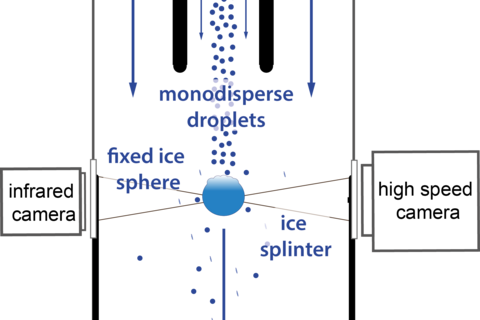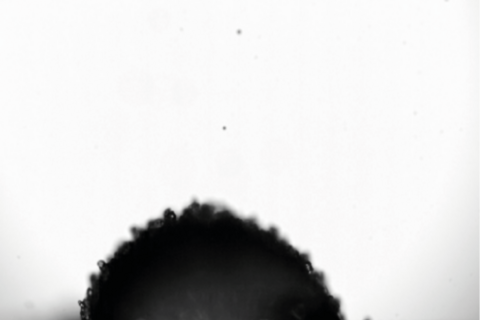Mixed-phase clouds are essential elements in Earth’s weather and climate system, exist at temperatures between 0°C and -38°C and are characterized by simultaneously occurring supercooled liquid water droplets and ice particles (Fig. 1). Primary ice particles are formed via nucleation processes. Above approx. -38°C ice nucleation takes place if an ice nucleating particle (INP) catalyzes the process. Aircraft measurements of particular mixed-phase clouds demonstrated a strong discrepancy between the observed ice particle and INP number concentration of one to four orders of magnitude [1-5]. Secondary ice production (SIP) mechanisms such as mechanical fragmentation or sublimation of ice crystals, droplet shattering on freezing and ice splinter production due to droplet-ice collisions and ice-ice collisions have been hypothesized [6-8] which can increase the total ice particle number concentration by multiplication of primary ice particles and hence might explain the observed discrepancy.
Here at TROPOS, we focus on a SIP mechanism which is a consequence of droplet-ice collisions, i.e. when small supercooled droplets freeze upon contact with a larger ice particle (rimer or graupel, Fig. 2) and eject small ice splinters under certain conditions to be determined. Commonly, this SIP mechanisms is known as Hallett-Mossop [8] or rime-splintering process.
The DFG funded project is a joined project together with the Institute of Meteorology and Climate Research of the Karlsruhe Institute of Technology (KIT) [10, 11].
The main objectives of the project are:
- Development of a new experimental set-up for investigating secondary ice particle production via droplet-ice collision and droplet shattering on freezing
- Identification of the SIP underlying physical mechanisms for both processes
- Quantification of the number of secondary produced ice particles for both processes.
The new experimental set-up IDEFIX (‘Ice Droplets splintEring on FreezIng eXperiment’) is developed, built, characterized and first experiments were conducted successfully in close cooperation with KIT at TROPOS.
This project is funded by the German Research Foundation DFG (grant HA 8322/1-1).
References:
- Mossop, S.C., The origin and concentration of ice crystals in clouds, Bulletin of the American Meteorological Society, doi: 10.1175/1520-0477(1985)066<0264:toacoi>2.0.co;2, 1985.
- Hobbs, P.V. and A.L. Rangno, Ice Particle Concentrations In Clouds, Journal of the Atmospheric Sciences, 1985.
- Hogan, R.J. et al., Properties of embedded convection in warm-frontal mixed-phase cloud from aircraft and polarimetric radar, Quarterly Journal of the Royal Meteorological Society, doi: 10.1256/003590002321042054, 2002.
- Taylor, J.W. et al., Observations of cloud microphysics and ice formation during COPE, Atmos. Chem. Phys., doi: 10.5194/acp-16-799-2016, 2016.
- Crosier, J. et al., Observations of ice multiplication in a weakly convective cell embedded in supercooled mid-level stratus, Atmospheric Chemistry and Physics, doi: 10.5194/acp-11-257-2011, 2011.
- Pruppacher, H.R. and J.D. Klett, Microphysics of Clouds and Precipitation. 2010, Springer Dordrecht.
- Field, P.R. et al., Chapter 7. Secondary Ice Production - current state of the science and recommendations for the future, Meteorological Monographs, doi: 10.1175/amsmonographs-d-16-0014.1, 2016.
- Korolev, A., & Leisner, T., Review of experimental studies of secondary ice production, Atmospheric Chemistry and Physics, doi:10.5194/acp-20-11767-2020, 2020.
- Hallett, J. and S.C. Mossop, Production of secondary ice particles during riming process, Nature, doi: 10.1038/249026a0, 1974.
- Keinert, Alice, Dominik Spannagel, Thomas Leisner, and Alexei Kiselev, Secondary Ice Production upon Freezing of Freely Falling Drizzle Droplets, Journal of the Atmospheric Sciences, doi: 10.1175/jas-d-20-0081.1, 2020.
- Kleinheins, J., Kiselev, A., Keinert, A., Kind, M., & Leisner, T., Thermal Imaging of Freezing Drizzle Droplets: Pressure Release Events as a Source of Secondary Ice Particles, Journal of the Atmospheric Sciences, doi:10.1175/jas-d-20-0323.1, 2021.



